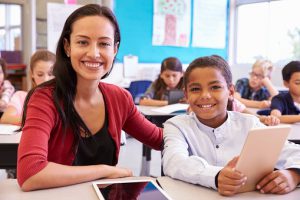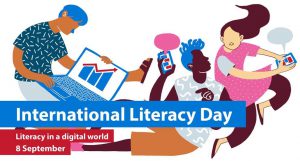

President to Announce New Fund for Bilingual Programs
French President Emmanuel Macron will launch a new fund to support French-English bilingual programs in the U.S. on September 20 during his trip to New York for the opening of the UN General Assembly. Macron’s support of bilingual education has already been evidenced by his decision to “restore” bilingual classes in France.
The fund, which is supported by corporations including Chanel, Axa, Bic, and Best Buy, will provide $150,000 per year for five years to cover human and material needs for bilingual programs launched in public American schools during the last few years. There are some 150 such programs across the country.
According to French Embassy’s Cultural Counselor Bénédicte de Montlaur, “It’s about creating a support mechanism that can make the difference.” Schools benefitting from the fund, which has already reached $1.4 million, will be announced in October, so funding requests are required this month.
Funding specifically for the instruction of French teachers, of which there is a shortage despite the boom in bilingual programs, will also be offered.
France Welcomes Community College Students
In another move to promote relations between these old allies, the Cultural and Scientific Services of the French Embassy in Washington launched a two-part program entitled “Community College Abroad in France”, in partnership with Community Colleges for International Development and the n+i network (50 top engineering schools network in France). The Community College Abroad in France program includes two components: a 10-day, non-degree-granting summer bootcamp in June 2017, and a four-year degree-granting program starting Summer 2017.
Part of the “Transatlantic Friendship and Mobility Initiative”, a dual initiative of the U.S. Department of State and the French Ministry of Foreign Affairs launched in 2014 to increase and diversify student mobility cross-Atlantic, the Community College program echoes the French Embassy’s mission to reach new audiences, in this case, American students traditionally underrepresented in study abroad programs.
Seventeen community college students from across the US specializing in engineering and environmental science took part in this Juen’s 10-day, non-degree-granting pilot bootcamp in Paris. The program included a series of professional and scientific visits to learn about air quality control (Ballon d’air de Paris), environmental management practices for water distribution (Usine d’Austerlitz), innovative urban transportation, and lighting management in Paris.
Offering graduate studies abroad, the four-year degree-granting program in France is open to a small group of hand-selected students, following the completion of their two-year Associate degree at a U.S. community college with honors. Selected students are offered the opportunity to complete a Diplôme d’ingénieur (Engineering Degree) within four years of graduating from a community college.
Students begin the program with a pre-Diplôme d’ingénieur, a preparatory year in France, which allows them to become acquainted with new methods of study and to strengthen their French language skills. This is followed by a 3-year work-study Diplôme d’ingénieur at one of the 50 top engineering schools of the n+i network.
The program is designed to offer students professionalized training while enabling them to auto finance their degree. Students attend classes part-time while completing a paid part-time internship.
The French Embassy also offers one student a scholarship to finance the pre-Diplôme d’ingénieur year in France. This year, the laureate is Daniela Markovic from the honors college at Lonestar College in Houston Texas. She will start July 2017.
Community College Abroad in France aims to open up the classic junior-year-abroad experience to community college students. Amid soaring tuition prices in the US, they make up a significant portion of America’s post-high school student body but rarely find the means or programs to do some of their studies internationally.
A according to the Community College Research Center at Columbia University, 39% of all undergraduates in the 2015-16 school year in the U.S. were at two-year community colleges, but only 2% of them studied abroad.
Focused on students studying engineering and environmental science, the program – which aims to expand next year – also brings top talent from U.S. schools to France, and in doing so, gives the American community college system a chance to counter enduring stigmas, sometimes even among its own students.
Discount Code for ELL Strategies Guides
 Visit ELLGuide.com and use code FCAD473 for 25% discount ($9.95) on ELL Strategies Guides for all educators responsible for ELL instruction
Visit ELLGuide.com and use code FCAD473 for 25% discount ($9.95) on ELL Strategies Guides for all educators responsible for ELL instruction
Talk, Read, Talk, Write
 Nancy Motley suggests a routine for literacy in all content areas
Nancy Motley suggests a routine for literacy in all content areas
Teachers often feel immense pressure to cover too much material in too little time. They work tirelessly to ensure that their students are adequately prepared for the high-stakes testing that permeates the world of education. In addition to these accountability measures, today’s teachers are asked to communicate a dense and rigorous curriculum to classrooms full of students who have widely varying needs.
In their committed efforts to meet and exceed these expectations, instructional focus can get lost. It is time to move away from a spotlight that is solely placed on curriculum and instead shift back to successfully teaching students. In particular, we need to teach students how to think for themselves.
Students often spend much of their school day listening to teachers and then completing assignments related to the teachers’ mini-lessons or lectures. They have limited opportunities to orally process what they are learning, to make meaning in the company of their peers, and to read or write for authentic purposes. Why is this? Time. It takes time for students to talk, read, and write about academic topics. It is precious time that teachers are not sure they can afford to give.
As Schmoker (2011) clearly explains, however, “It should go without saying that most students won’t optimally learn facts (much less care about them) without abundant opportunities to read, write, and talk.”
Many leaders in the field of literacy, as well as those in educational research, contend that in order for students to achieve at the highest levels, they must actively participate in learning through conversation, reading, and writing (Wilkinson and Silliman, 2000; Tovani, 2004; Daniels and Zemelman, 2004; Gallagher, 2004; Zwiers, 2008). Students develop deep conceptual knowledge in a discipline only by using the habits of reading, writing, and thinking (McConachie et al., 2006; Schleppegrell, 2004).
In other words, in order for students with a vast array of needs to master dense, rigorous curriculum and to demonstrate success on high-stakes assessments, they must have consistent opportunities to talk, read, and write about content-area concepts.
To meet this challenge, teachers may reconcile their constrained time with the need to provide students opportunities for critical literacy practice by adopting the talk, read, talk, write (TRTW) routine.
TRTW is a simple way to deliver content that is centered around students’ practice of literacy skills rather than centered on a teacher’s direct teaching of a concept.
The TRTW routine can be used to teach an entire lesson but is also easily adapted as a routine for teaching individual terms or concepts.
At its core, students are reading a text to learn, rather than listening to their teacher to learn. In addition to reading the text, students engage in structured opportunities to discuss and write about the content.
The TRTW framework is instructionally significant for several reasons. Paramount on the list is that no student, not even the struggling reader, is invisible. All students participate in two conversations with peers, and those conversations directly support their ability to successfully complete both the reading and the writing tasks embedded in the lesson.
Additionally, there are many ways to differentiate within this approach. The selection of the text itself is a differentiation point. For example, a teacher can provide a grade-level article to the majority of the students in his or her class as well as a simplified version of the same article to any readers who are not proficient enough for the original text. The teacher could also provide a more advanced option, offering students a bank of additional resources that also meet the students’ same purpose for reading. Other ways to differentiate the text include providing copies with key points highlighted, teacher notes in the margin of the text, online versions of the text, or native-language text for beginner English language learners.
Differentiating the task is another effective option. For example, the teacher can have more than one purpose for reading a text. Some students may read for a literal and basic purpose, while others might read for a more inferential or evaluative purpose. The teacher can provide more than one version of any graphic organizer or note-taking support in order to specifically target what individual students should focus on during the reading. Furthermore, the writing task does not need to be the same for all students.
Some students might also need differentiation within the talking tasks. Teachers can give sentence stems and word banks to those needing additional support. Another option is to provide different questions to different groups of students. Some discussion groups only have the capacity to address one question at a time, while others could benefit from a list of questions that increase in complexity.
Lastly, the structure of this approach gives valuable time back to the teacher. While students are talking, reading, and writing, the teacher can provide individualized support for those who are struggling. Teachers are no longer the “sage on the stage” but rather true facilitators, equipped with the tools to consistently provide differentiated support as needed throughout the lesson.
Aside from differentiation, another significant benefit of the TRTW routine is that every step of the process builds academic language. Students are listening, speaking, reading, and writing in the language of the content area. They are active users of academic language, rather than passive observers of the teacher’s use of academic language. The responsibility for learning is shared with and then passed on to the students. The TRTW routine requires the students, not the teacher, to accept responsibility for learning. When they do, they become independent thinkers and problem solvers prepared for tasks both within and beyond our classrooms.
Bibliography
Daniels, H. and Zemelman, S. (2004). Subjects Matter: Every Teacher’s Guide to Content-Area Reading. Portsmouth, NH: Heinemann.
McConachie, S., Hall, M., Resnick, L., Ravi, A. K., Bill, V. L., Bitz, J. and Taylor, J. A. (October 2006). “Task, Text, and Talk.” Educational Leadership 64, no. 2, p. 8–14.
Motley, N. (2016). Talk, Read, Talk, Write: A Practical Routine for Learning in All Content Areas (K–12), 2nd ed. San Clemente, CA: Canter Press.
Schleppegrell, M. J. (2004). The Language of Schooling: A Functional Linguistics Perspective. Mahwah, NJ: Lawrence Erlbaum Associates.
Schmoker, M. (2011). Focus: Elevating the Essentials to Radically Improve Student Learning. Alexandria, VA: ASCD.
Tovani, C. (2004). Do I Really Have to Teach Reading? Portland, ME: Stenhouse.
Wilkinson, L. C., and Sillman, E. R. (2000). “Classroom Language and Literacy Learning.” In M. L. Kamil, P. B. Mosenthal, P. D. Pearson, and R. Barr (eds.) Handbook of Reading Research, Vol. 3, p. 337–360. Mahwah, NJ: Lawrence Erlbaum Associates.
Zwiers, J. (2014). Building Academic Language: Essential Practices for Content Classrooms. 2nd ed. San Francisco, CA: Joley-Bass.
Nancy Motley is an educational consultant for Seidlitz Education and the author of Talk, Read, Talk, Write: A Practical Approach to Learning in the Secondary Classroom. She is also the co-author of The Diverse Learner Flip Book and has developed a variety of training sessions in thinking strategies, vocabulary development, nonfiction reading and writing, and ELPS implementation.
Nancy’s previous educational roles have included classroom teacher, reading specialist, intervention program coordinator, professional development instructor, and curriculum developer.
She was awarded the Alief ISD’s Teacher of the Year Award in 2003. While teaching for Alief in Houston, Texas, she specialized in increasing student achievement for a variety of special populations, including English language learners and students with dyslexia.
$20 Million in Federal Grants for ELL Teacher Development

 The U.S. Department of Education’s Office of English Language Acquisition (OELA) has announced the awarding of $20 million in grants under the National Professional Development Program (NPD), to support educators of English learner students.
The U.S. Department of Education’s Office of English Language Acquisition (OELA) has announced the awarding of $20 million in grants under the National Professional Development Program (NPD), to support educators of English learner students.
The NPD program provides grants to eligible institutions of higher education and public or private entities with relevant experience and capacity, in consortia with states or districts, to implement professional development activities that will improve instruction for English Learners (ELs). Professional development may include preservice or in-service activities for educators of ELs including teachers, administrators, paraprofessionals or other educators working with ELs. Professional development activities may include teacher education programs and training for other education professionals that lead to certification, licensing, or endorsement for providing instruction to English learners.
“Our English learner students represent an incredible asset for our country, yet they also face unique challenges. We need to keep shining the spotlight on them and building our capacity to better serve and teach them.” said OELA Assistant Deputy Secretary, José A.Viana. “With this funding, we continue to deliver on our promise of equity, excellence and opportunity in supporting educators, students and families across the country. They are counting on us to help them soar!”
A full list of grant recipients will be released by the end of the month, and the Department projects this new cohort of 42 grants will serve nearly 2,000 pre-service and 10,000 in-service teachers.
Ontario to Open First French-Language University

 The Canadian province of Ontario is proposing to create a new French-language university, the first of its kind in the majority English-speaking province, giving French-speaking students more opportunities to study in French.
The Canadian province of Ontario is proposing to create a new French-language university, the first of its kind in the majority English-speaking province, giving French-speaking students more opportunities to study in French.
In consultation with the francophone community, the French-Language University Planning Board has recommended the creation of a French-language university in the Toronto area, governed by and for francophones. After careful review, Ontario will be accepting the key recommendations of the report and intends to introduce legislation for the creation of the proposed university in the coming months.
Creating more postsecondary education options for students is part of a plan to create jobs, grow the economy, and help people in their everyday lives.
Ontario is home to 611,500 francophones—the largest population in Canada outside of Québec—with central and southwestern Ontario home to the fastest-growing francophone population.
About 430,000 people in the greater Toronto area speak French, which makes it the fourth-most-important center of French-language speakers in Canada. In 2015–16, the Ontario government invested $87.9 million to support French-language postsecondary education, including almost $14 million from the federal government—an increase of more than 71% since 2003–04. In partnership with the federal government, the government of Ontario has invested more than $204 million in capital projects since 2008 to support French-language postsecondary education.
“Francophone culture and the French language have always been essential to Ontario’s identity and prosperity. This is strongly reaffirmed today with the government’s intent to provide high-quality postsecondary education to francophone students. The creation of a new French-language university, governed by and for francophones, is a critical milestone for Franco-Ontarians and future generations,” commented Marie-France Lalonde, minister of francophone affairs.
Celebrate International Literacy Day


Literacy in a digital world
Today, International Literacy Day (8 September) will be celebrated across the world under the theme of ‘Literacy in a digital world’. A global event is taking place at UNESCO’s Headquarters in Paris, with the overall aim to look at what kind of literacy skills people need to navigate increasingly digitally-mediated societies, and to explore effective literacy policies and programs that can leverage the opportunities that the digital world provides.
The 2017 UNESCO International Literacy Prizes awards ceremony will also take place to recognize and reward excellent literacy practices from around the world in connection with this year’s theme and as a key target in Sustainable Development Goal 4.
International Literacy Day is celebrated annually worldwide and brings together governments, multi- and bilateral organizations, NGOs, private sectors, communities, teachers, learners and experts in the field. It is an occasion to mark achievements and reflect on ways to counter remaining challenges for the promotion of literacy as an integral part of lifelong learning within and beyond the 2030 Education Agenda.
Message from Ms Irina Bokova, Director-General of UNESCO on the occasion of International Literacy Day:
Digital technologies permeate all spheres of our lives, fundamentally shaping how we live, work, learn and socialize.
These new technologies are opening vast new opportunities to improve our lives and connect globally — but they can also marginalize those who lack the essential skills, like literacy, needed to navigate them.
Traditionally, literacy has been considered a set of reading, writing and counting skills applied in a certain context. Digitally-mediated knowledge societies are changing what it means to be literate, calling for new and higher-level literacy skills. At the same time, in return, technology can work to improve literacy development.
This must be understood in the wider context. Worldwide, 750 million adults today still lack even the most basic literacy skills. Some 264 million children and youth are not benefiting from school education. Furthermore, international surveys show that a large share of adult and youth populations all over the world, including developed countries, are inadequately equipped with the basic digital skills required to function fully in today’s societies and workplace. Narrowing this skills gap is an educational and developmental imperative.
Information and communication technologies are creating opportunities to address this challenge. Digital tools can help expand access to learning and improve its quality. They have the power to reach the unreached, improve the monitoring of literacy progress, facilitate skills assessment, and make the management and governance of skills delivery systems more efficient.
To create and seize new opportunities to take forward Sustainable Development Goal 4 on Education and lifelong learning for all, we need collective action. Partnerships between governments, civil society and the private sector are essential today to promote literacy in a digital world. I see the Global Alliance for Literacy within a Lifelong Learning Framework as a model of the concerted efforts we need to advance the global agenda and support national literacy initiatives.
International Literacy Day offers a moment to review the progress and come together to tackle the challenges ahead. This year, the event is devoted to better understanding the type of literacy required in a digital world to build more inclusive, equitable and sustainable societies. Everyone should be able to make the most of the benefits of the new digital age, for human rights, for dialogue and exchange, for more sustainable development.
Irina Bokova
Trump Ends American DREAMers’ Hopes

 Today, the Trump administration announced its decision to end the Deferred Action for Childhood Arrivals (DACA) while calling on Congress to overhaul immigration legislation. The program, started during the Obama administration in 2012, has allowed about 800,000 of those who immigrated to the U.S. as children without documentation to work and study in this country. Although the administration claims it is merely correcting an unconstitutional presidential overreach, some commentators see it as a ploy to provoke Congress into action. Whatever the underlying reason for it, the move is deeply unpopular with the American people—a new poll finds that more than 75% of U.S. citizens support the idea of allowing Dreamers to become citizens or to remain as permanent residents.
Today, the Trump administration announced its decision to end the Deferred Action for Childhood Arrivals (DACA) while calling on Congress to overhaul immigration legislation. The program, started during the Obama administration in 2012, has allowed about 800,000 of those who immigrated to the U.S. as children without documentation to work and study in this country. Although the administration claims it is merely correcting an unconstitutional presidential overreach, some commentators see it as a ploy to provoke Congress into action. Whatever the underlying reason for it, the move is deeply unpopular with the American people—a new poll finds that more than 75% of U.S. citizens support the idea of allowing Dreamers to become citizens or to remain as permanent residents.Attorney General Jeff Sessions, who made the announcement, called DACA a “unilateral executive amnesty.” Sessions also called DACA an “open-ended circumvention of immigration laws” and an “unconstitutional exercise of authority” by the Obama administration.
Despite some bipartisan support for the bill, the issue still divides many lawmakers. House Speaker Paul Ryan, R-Wis., responded to the announcement in a statement saying, “It is my hope that the House and Senate, with the president’s leadership, will be able to find consensus on a permanent legislative solution that includes ensuring that those who have done nothing wrong can still contribute as a valued part of this great country,” while Sen. Cory Booker, D-NJ, tweeted: “Today’s decision to end #DACA is a moral catastrophe that shakes the American Dream to its core.”
The new poll from Morning Consult and Politico was conducted from August 31st through September 3rd and the sample was comprised of 1,993 registered voters. When asked, “As you may know, Dreamers are young people who were brought to the United States illegally when they were children, often with their parents. Which of the following do you think is the best way to handle Dreamers?”
• 76% of Americans support citizenship (58%) or permanent status (18%) for Dreamers, while only 15% back deportation.
• 84% of Democrats back either citizenship (71%) or permanent status (13%), vs. 8% who favor deportation.
• 74% of Independents back either citizenship (56%) or permanent status (18%), vs. 12% who favor deportation.
• 69% of Republicans back either citizenship (46%) or permanent status (23%), vs. 24% who favor deportation.
• The poll crosstabs reveal that a combined 67% of Trump voters back either citizenship (44%) or permanent status (23%), vs. 26% in favor of deportation.
Response to DACA’s demise was swift:
California state superintendent of public instruction Tom Torlakson denounced the decision and told California public school students and their families that California will keep protecting and supporting them, saying: “Our country made an honest deal with these students—study hard, earn your degree, and you will get a fair chance to compete for college. We should keep deals, not break them. We should support dreams, not defer and destroy them.” He added: “I urge Congress to step up, find a permanent path to citizenship, and protect these immigrants.”
Mario Carrillo, state director of America’s Voice Texas, said, “In his most cowardly decision as president yet, Trump has reneged on his assurances to Dreamers that they had nothing fear, but has instead cowered to Texas attorney general Ken Paxton. The Texas attorney general was the force behind ending the successful program, which has benefited more than 120,000 young Texans. As our state continues to rebuild from the devastation of Hurricane Harvey, Paxton made the continued attack on immigrants his top priority. That will never be forgotten. He is going to see that our community will not back down. We recommit our fight to protect immigrant youth and their families, who make Texas and our country great.”
Esther Brimmer, executive director and CEO of NAFSA: Association of International Educators, commented: “Today, we stand with immigration advocates across the country in demanding Congress pass a clean version of the bipartisan Dream Act and give these young men and women a path to citizenship, immediately. We must not shut the doors to the American dream or put people at risk of deportation who have already demonstrated that they contribute to and enrich America. Like the generations of immigrants who came before them, DACA recipients love America and deserve the chance to prosper and thrive.”
American Federation of Teachers president Randi Weingarten commented: “President Trump made a promise that he would treat Dreamers with ‘great heart.’ Now, for seemingly political reasons, he is breaking his promise to students, teachers, doctors, nurses and lawyers who took him at his word. This is not the America I know—an America that says one thing to its citizens and then does another. Betraying DACA Dreamers is betraying the values of our diverse and welcoming nation. America will not be stronger or more secure when these young people are torn away from the country they love and call their own. America will be diminished—and the toll will be measured by families ripped apart, people cast into the shadows and into poverty, businesses upended, economies weakened and dreams shattered…As children return to school, many carry with them constant, crippling terror and uncertainty because of their immigration status. Children should be free to learn and live without fear. Inhumane immigration policies deprive them of that freedom.”
Dan Stein, president of the Federation for American Immigration Reform FAIR, which campaigns to limit immigration, sees the issue differently: “FAIR applauds the decision by President Trump to wind down the DACA program…In our view, DACA was an unconstitutional abuse of executive authority by President Obama…Congress should seize this opportunity to come together and forge these much-needed reforms in our nation’s immigration policy. If the Democrats fail to show up at the negotiating table, it raises the legitimate question of whether DACA is something that the Democrats really want, or if it has merely been used as a convenient political football for fundraising and energizing their base.”
Americans Support Public Education in Diverse Schools
 Despite influential campaigns to undermine confidence in public schools, most Americans have faith in their local schools, according to the latest edition of the annual Phi Delta Kappa International (PDK) Poll of the Public’s Attitudes Toward the Public Schools, the defining public opinion survey on American public education for the past 49 years.
Despite influential campaigns to undermine confidence in public schools, most Americans have faith in their local schools, according to the latest edition of the annual Phi Delta Kappa International (PDK) Poll of the Public’s Attitudes Toward the Public Schools, the defining public opinion survey on American public education for the past 49 years.
The new poll finds that the proportion of Americans who give their community’s public schools an A grade is at its highest in more than 40 years, and 62% of public school parents gave public schools in their own communities an A or B grade, compared with 45% of nonparents. When parents grade their own kids’ schools, the results are even better, with 71% giving them A’s or B’s. This compares with only 24% of Americans giving public schools nationally an A or B (with no difference between parents and all adults), and the report notes: “There’s no contradiction in the gap. Awareness of a few poor schools can diminish the ratings of all schools together, driving down scores nationally while leaving local scores far better.”
The survey also found that 70% of parents, including equal numbers of whites and nonwhites, say they’d prefer to have their child in a racially diverse school, but only a quarter of those who say they’d like their child to attend a racially diverse school would be willing to take on a longer commute to do it.
Despite the current emphasis on vouchers among federal policymakers, the poll found that 52% of Americans oppose using public funds to send students to private school and opposition rises to 61% when the issue is described in more detail.
Contrary to expectations, the survey found that standardized testing was the least important factor in assessing school quality. All other factors, including the availability of extracurricular activities, art and music classes, advanced academic classes, technology and engineering classes, and programs to develop interpersonal skills, were deemed more important.
An overwhelming majority of Americans (87%) strongly support schools providing mental health services and after-school programs (92%). They’re willing to pay for it too – 75% of respondents say schools should ask for more public money to provide these and other such wraparound services.
Making Learning Come to Life


 Trish Roffey creates makerspaces to embolden and empower English learners and struggling students
Trish Roffey creates makerspaces to embolden and empower English learners and struggling students
“Ultimately, the outcome of maker education and educational makerspaces leads to determination, independence, and creative problem solving, and an authentic preparation for the real world through simulating real-world challenges. In short, an educational makerspace is less of a classroom and more of a motivational speech without words” (Kurti et al., 2014, p. 11).
Have you ever considered how many parents ask their child the question “What did you do in school today?” to only be answered with “Meh,” “I don’t know,” or “Nothing”? Parents want to know what their children have spent their days learning and are often faced with unenthused responses or no responses at all. This leads to the inevitable concern that their children haven’t learned anything, are struggling, or are unhappy with school. This concern can be increased tenfold when their children are new to learning the language or have special needs. The year 2015 brought about a change in this passive response with the entrance of makerspace in education. Before we all roll our eyes at yet another educational buzzword, makerspace is actually the resurgence of the foundational educational pedagogy of constructivism and is changing the nature of teaching and learning. Now, when the question “What did you do in school today?” is asked, parents are being shown projects that provided the best seven hours of their children’s lives, thanks to the makerspace.
Makerspace is a global trend that is part of the DIY movement.
These spaces started as community centers where the average Joe could meet up with local experts to pursue a passion project or hobby. Imagine a facility with tools and materials to invent, tinker, and construct. This movement has found its way into education over the last year. Libraries and classrooms are being transformed with 3D printers, robots, and bins of recycled materials. What is exciting is that makerspace is more than just a space; it is an educational mindset. A makerspace mindset allows educators to shift away from ready-made knowledge to a classroom environment ripe for exploration, creativity, innovation, and collaboration, with hands-on materials and real-world problems (Donaldson, 2014; Papert and Harel, 1991; Schön, Ebner, and Kumar, 2014; Schrock, 2014; Hatch, 2013). In short, teachers are changing the way they teach, which is causing students to change the way they learn, and this is a very good thing.
With an ever-growing student population of English language learners (ELLs) in our schools across North America, we need to consider our approach to offering higher-level learning opportunities that also support the development of language and social skills. Often, we can observe students who are missing “foundational” literacy and numeracy being pulled out of the classroom to receive one-on-one instruction for these missing pieces because they “must learn this before they can learn that.” Makerspace is allowing students who are “missing pieces” to still learn, reason, problem solve, and innovate without having to rely on mastery of the English language. My own mindset as an educator had to shift when I began teaching in an inner-city school environment for a group of students that had severe special needs. Our school population was also over 70% ELLs. The opportunity to “pull out” students who struggled was gone when it would have meant pulling out more than half the class. I started to ask myself, if I only relied on teaching the basics, when would they have the chance to shine? I was inspired by the story of The Boy Who Harnessed the Wind.
William Kamkwamba was a 14-year-old boy living in extreme poverty and famine in Malawi in 2002. He was forced to drop out of school and spent much of his time at the local library flipping through magazines and books about electronics. One day, he was inspired to build a windmill for his community as a way to provide electricity and irrigation. Using blue gum trees, bicycle parts, and materials collected in a local scrapyard, William constructed a very rough but very functional windmill that could power a cell phone. He did not have a teacher telling him step by step what he had to do, he was not receiving remediation for the English language, yet he was still learning. William was inspired to solve a problem, he had a reason to learn, and he was able to make his learning come to life. This story challenged me as an educator to provide this kind of learning environment—for all learners, regardless of ability.
My classroom began to shift. When it was time to write a story, we took a break from papers and pencils and instead brought out Dash and Dot robots. Students who would have relied on an adult to read and scribe for them were now learning how to use drag-and-drop blocks of code to program their bots to act out the stories in their minds. They designed costumes, they made cardboard settings, and some of them told the first stories in their school careers. When it was time for math, we used an inexpensive drone to explore distance, speed, angles, and weight as we built devices to deliver necessary medical supplies to war-torn regions, a concept many of my students understood the need for all too well. When it was time for science, we used a Raspberry Pi computer and camera to create a time-lapse security camera to understand the nocturnal habits of our beloved classroom chinchilla.
This mini maker movement started to show me for the first time not what the students could not do, but what they could do. They displayed learning that was previously inconceivable simply because they had never been given the opportunity. This type of learning in our schools is often reserved for the best and the brightest students. Yet after allowing my classroom to become a launch pad for learning, there was a noticeable decrease in classroom misbehavior, students had less anxiety, and there was a dramatic increase in engagement in learning, expressive language, reading ability, and foundational numeracy. Suddenly we were designing websites instead of writing reports for social studies; we hacked our word wall with the Makey Makey so it could talk instead of memorizing flash cards; we built flight simulators out of recycled materials using Google Earth instead of reading about aerodynamics in a textbook.
Throughout all of this, we sought out community experts, we researched blogs, we used tools, we created art, we tested, designed, and improved, we made mistakes, and finally we made learning come to life. This was a passionate group of learners committed to a goal. Some of our students could not read, some had trouble sitting still, some needed a little more help, but all had a chance to shine. These projects turned out to be the greatest year of learning ever, something everyone still talks about. Shouldn’t every student have the chance to learn the same way? By moving makerspaces from our garages and community centers into our schools, we have this chance.
Making is a universal language of learning. This hands-on, physical expression of understanding can allow for both students and parents who are English language learners to see and hold what has been learned. This can be done in any school, with any students, on any budget. My first “makerspace” was a bin of materials from the dollar store and a $35 Raspberry Pi computer. A makerspace is about good teaching and learning, period. Educators do not need to be intimidated by high-tech, expensive facilities.
Educators can start small, with one idea and project, and build momentum from there. The maker movement is a vehicle that will allow schools to be part of the necessary return to constructivist education—a movement that will allow students to be creative, innovative, independent, and technologically literate. It is not an “alternative” way to learn, but what modern learning should really look like (Stager, 2014). For our ELL and struggling students, this movement will help better prepare them for a world where they can be computer programmers, engineers, and inventors far beyond what remedial educational alone could have done. We need to believe they can do it, and we owe it to their future to try.
In the movie Cast Away, starring Tom Hanks, there is a moment in which he makes fire—a passionate event in which he was the creator of an epic moment of learning, so much so that he shouted “I made fire” to the heavens. This is the moment we want for our children. We want school to be an opportunity to make fire and love learning so that they come home and cannot stop talking about that moment. The greatest seven hours of their lives. That is an educational makerspace.
Trish Roffey is an emerging technology consultant for Edmonton Catholic Schools in Edmonton, Alberta, Canada. In this role, Trish specializes in supporting teachers and students to explore makerspace, assistive technology, coding and robotics, and blended learning. Trish is also an avid maker who is always tinkering on her next project. You can follow Trish on Twitter @MrsRoffey or contact her at [email protected]. For more information about educational makerspaces and to explore project ideas mentioned in this story, please visit www.makerspaceforeducation.com.
Support for Russian in Ukraine
 Thirty percent of Ukrainians in areas controlled by the Kiev government support granting official status to the Russian language, according to a new survey.
Thirty percent of Ukrainians in areas controlled by the Kiev government support granting official status to the Russian language, according to a new survey.
The poll, conducted by the Ilko Kucheriv Democratic Initiatives Foundation, found that 54.4% of Ukrainians were against Russian becoming an official language and another 15% of the respondents found it difficult to answer the question.
Four years ago, a similar survey found 32.2% of respondents in favor of Russian being official, and in 2016, the figure decreased to 30.3%, the survey noted.
The poll was carried out in July among 1,800 people in various parts of Ukraine with a less than the 2.3-percent margin of error. In war-torn eastern Ukraine, people were surveyed only in areas controlled by Kiev.
In 2014, the Ukrainian parliament (Verkhovna Rada) ruled that the Russian language’s official status in 13 out of 27 of the country’s regions was no longer valid. In January 2017, the Verkhovna Rada passed the “official language” bill which stipulates the sole use of the Ukrainian language in all official communications. According to the bill, the Ukrainian language must be used by government and local authorities, and all educational establishments.
The Ilko Kucheriv Democratic Initiatives Foundation (DIF) grew from the Ukrainian citizens’ movement (Narodny Rukh) in 1992 to pursue the ideas of Rukh activists on developing an independent Ukraine’s state and governance, market economy, and civil society. According to the Policy Association for an Open Society, a Western-leaning network of policy centers, “DIF has acquired a reputation as a highly respected research and education organization, and a credible source of information. DIF’s track record includes more than 200 accomplished research projects, hundreds of analytical publications, and several internet resources.”


